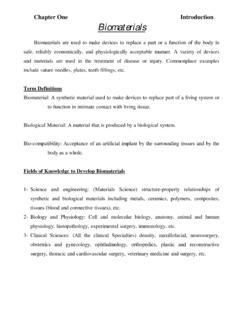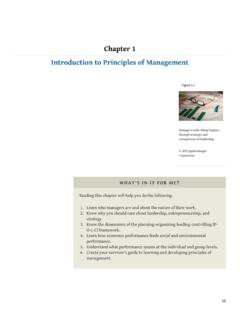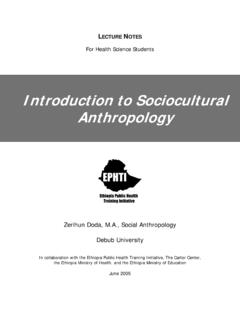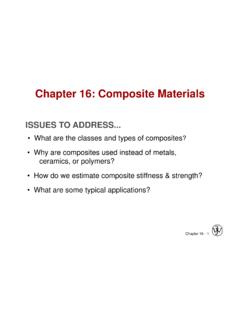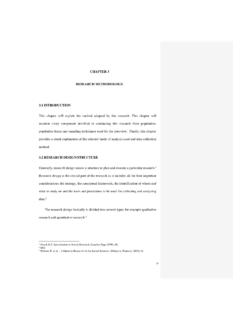Transcription of Unit 1: Introduction to Environmental Science
1 Name: _____ unit 1: Introduction to Environmental Science Big Organisms are linked to one another in an ecosystem by the flow of energy and the cycling of materials. Humans are an integral part of the natural system and human activities can alter the stability of ecosystems. Science is a way of thinking about and investigating the world in which we all live. What is Environmental Science ? Why and how do we study it? and their environments are interconnected. in one part of the system will affect other parts of the system. can alter the living and nonliving factors within an ecosystem, thereby creating changes in the overall system. Vocabulary environment Environmental Science ecology ecosystem sustainability natural capital natural resources natural services nutrient cycling solar capital photosynthesis natural income economic growth economic development developed countries developing countries resource conservation perpetual resource renewable resource sustainable yield Environmental degradation nonrenewable resource ecological footprint pollution point source pollution nonpoint source pollution biodiversity nutrient cycling exponential population growth What you should know and be able to Environmental Science and explain why we study it the history of human impact on the environment the five basic causes of Environmental problems the main Environmental problems facing our world today how we can avoid the Tragedy of the Commons the scientific method.
2 Safely in the lab. Environmental Science / MendenhallUNIT 1: Introduction to Environmental Science1 / 26 Standards A4 C1 A1 A1 8, B1 2 (Source: BHPS Environmental Science Curriculum Guide Scope and Sequence) Date Activities & Homework Activities Course Introduction Big Ideas & Environmental Issues (due _____ ) Homework Study and sign the Laboratory Safety Contract (due _____ ) Complete and sign the ES Parent/Guardian Contact Sheet (due _____ ) Activities Tragedy of the Commons lab Homework Watch one of the 12 videos on the Ted Earth, appreciated playlist. Each video is between 7 and 27 minutes. Be able to explain why you chose the video, give a quick summary of it, and explain how it relates to Environmental Science . (due _____ ) Activities Video highlights Jigsaw chapter 1 ( 22): Environmental Problems, Their Causes, and Sustainability Activities Ecological footprint calculator Activities Tragedy of the Commons vignettes Video (:02) Chalk Talk: Tragedy of the Commons Activities history timeline Activities Jigsaw chapter S5 ( S30): Overview of Environmental History Activities Design Your Own Experiment Activities Review Activities unit 1 Test Environmental Science / MendenhallUNIT 1: Introduction to Environmental Science2 / 26 Date Do Now Environmental Science / MendenhallUNIT 1: Introduction to Environmental Science3 / 26 Environment 1.
3 What does environment mean to you? 2. Which of the following do you feel is the most important Environmental issue today? How would you define the issue? And why is it the most important? Atmosphere Water Land Energy Ecosystems Humans Other? Environmental Science / MendenhallUNIT 1: Introduction to Environmental Science4 / 26 3. Your group s issue: _____ Definition: Why you chose it: What you know about it: What you would like to know: Environmental Science / MendenhallUNIT 1: Introduction to Environmental Science5 / 26 Tragedy of the Commons Part 1: Commons Pond Procedure Work in groups of four. Imagine this scenario. Each person represents the head of a starving family, which requires food. The only food source for these four families is a small fishing hole that can accommodate an unknown amount of fish. Fortunately, after each round of fishing by the four family heads, each remaining fish is able to spontaneously reproduce.
4 Each person is allowed to take as many or few fish as you want, but if you take only one fish, your family will starve. In this simulation, our pond is a beaker, and our fish are goldfish crackers. Fish are caught using straws. Each fishing round will last for 1 minute. You should rotate your fishing order every round so that everyone has a chance to go first. The simulation will continue for three rounds. The pond will be covered with a fabric sleeve, so that it is not possible to tell how many fish have been taken before you fish. No talking is allowed in this part. Record all data in the following table. Data Table 1: Commons Pond Round # of fish at beg. of round # of fish taken by 1st fisher # of fish taken by 2nd fisher # of fish taken by 3rd fisher # of fish taken by 4th fisher total fish left at end of round 1 2 3 Total Environmental Science / MendenhallUNIT 1: Introduction to Environmental Science6 / 26 Questions 1.
5 What happened to the common resource in the in Part 1? Why? 2. Explain the rationale for your fishing technique in this part. 3. What factors lead to uncertainty in this round? Environmental Science / MendenhallUNIT 1: Introduction to Environmental Science7 / 26 Part 2: Commons Pond and Private Pond Procedure In this part, you will have access to two ponds, one common and one private. The rules for the common pond are the same as before. However, talking and strategizing is allowed in this part. The cloth sleeve will be removed so that you will know exactly how many fish are in the ponds at all times, and how quickly the fish will reproduce. The carrying capacity for the common ponds is 16 and for the private ponds is 4. You must remove at least one fish from each pond each round. As before, you may catch as many fish as you would like from both ponds during each round. Data Table 2: Commons Pond Round # of fish at beg. of round # of fish taken by 1st fisher # of fish taken by 2nd fisher # of fish taken by 3rd fisher # of fish taken by 4th fisher total fish left at end of round 1 2 3 Total Table 3: Private Pond Round # of fish at beg.
6 Of round # of fish taken this round # of fish at the end of round 1 2 3 Total Environmental Science / MendenhallUNIT 1: Introduction to Environmental Science8 / 26 Questions 1. Did you get different results for the pond in Part 2? Why? 2. Explain the rationale for your fishing technique in this part. 3. If you cooperated with other fishers, what was the result of that cooperation? 4. Did you use different fishing strategies in the common pond and the private pond? 5. Why does common usage lead to exploitation? Environmental Science / MendenhallUNIT 1: Introduction to Environmental Science9 / 26 6. What would be the ideal way to manage the common pond? 7. How would this simulation have been different if you didn't know the students in your group? 8. What are the strategies that help to prevent the "tragedy of the commons"? 9. If a new student had joined your group in the middle of Part 2, how would that affected your strategy and the use of the resource?
7 10. Why is the private pond easier to manage for long term success? Environmental Science / MendenhallUNIT 1: Introduction to Environmental Science10 / 26 Watch one of the 12 videos on the Ted Earth, appreciated playlist. Each video is between 7 and 27 minutes. Answer the following questions: Why did you choose the specific video? What is the video about? How does it relate to Environmental Science ? Environmental Science / MendenhallUNIT 1: Introduction to Environmental Science11 / 26 Environmental Problems, Their Causes, and Sustainability chapter 1 (pp. 6 21) Directions: This is a jigsaw where you get to be the teachers. You will start in a home group. Each member of the home group will be assigned one chapter section. You will then break up into expert groups to learn and prepare to teach the material to your home group. You will then return to your home group to teach your classmates what you have learned.
8 Please work quietly and efficiently within your groups. There will be a short quiz on the material at the end of the activity. With your expert group: the assigned section and then discuss the following questions: How can we put these ideas into our own words? What connections do we see between this material and what we already know or from personal experience? How will we tell the members of our home group about this material ? information to share with your home group. This should include: An answer to the section title s question. Important vocabulary. Answers to the relevant review questions listed below. With your home group: Share what you learned with your expert group. Ask questions for clarification and take notes. Environmental Science / MendenhallUNIT 1: Introduction to Environmental Science12 / 26 What is an environmentally sustainable society? (Questions #1,2, ) How can environmentally sustainable societies grow economically?
9 (Question #3, ) Environmental Science / MendenhallUNIT 1: Introduction to Environmental Science13 / 26 How are our Environmental footprints affecting the earth? (Questions #4,5, ) What is pollution and what can we do about it? (Questions #6, ) Environmental Science / MendenhallUNIT 1: Introduction to Environmental Science14 / 26 Why do we have Environmental problems? (Questions #7,8, ) What are the four scientific principles of sustainability? (Questions #9,10, ) Environmental Science / MendenhallUNIT 1: Introduction to Environmental Science15 / 26 Ecological Footprint Read the overview: Calculate your footprint: What part of your footprint can you influence? Environmental Science / MendenhallUNIT 1: Introduction to Environmental Science16 / 26 Tragedy of the Commons The "tragedy of the commons" is one of the most important topics in Environmental Science .
10 Many resources (ex. clean air, biodiversity, freshwater) are available to many people, and when resources are shared and limited (though potentially renewable), they are often exploited. This is because the benefit to one person of using more of the resource outweighs the cost to that individual of the resource's overuse. Each person looks out only for his own interests, and succumbs to the logic that, "If I don't use the resource, then someone else will. I might as well get the benefit." Learning to overcome our natural tendency to overuse common resources is one of the most significant challenges we face in working to improve the environment. Watch Chalk Talk: Tragedy of the Commons ( ) Read the following excerpts and answer the questions. Grand Banks fisheries The Grand Banks are fishing grounds off the coast of Newfoundland. For centuries, explorers and fishermen described this region as home to an endless supply of cod fish. In the 1960s and 1970s, advances in fishing technology allowed huge catches of cod.
